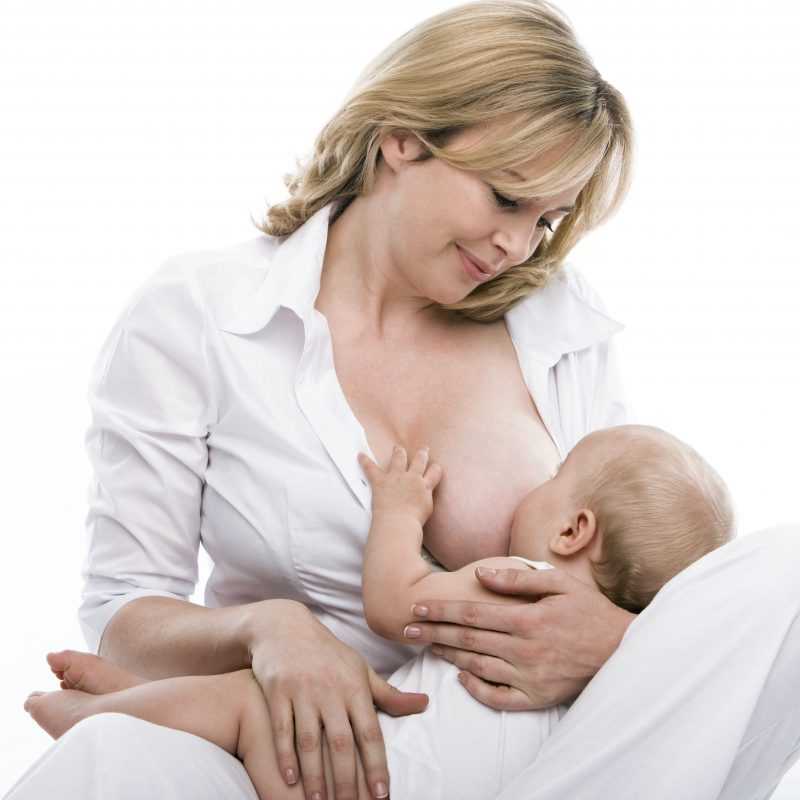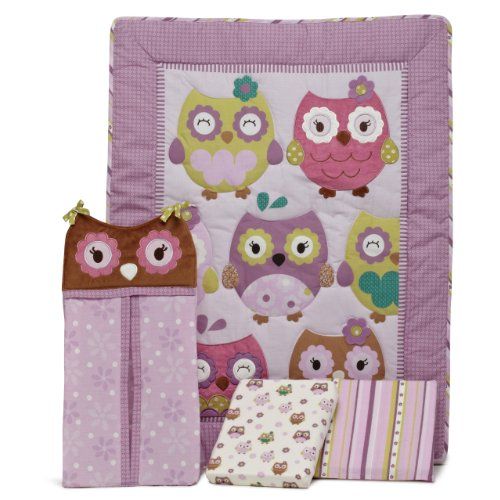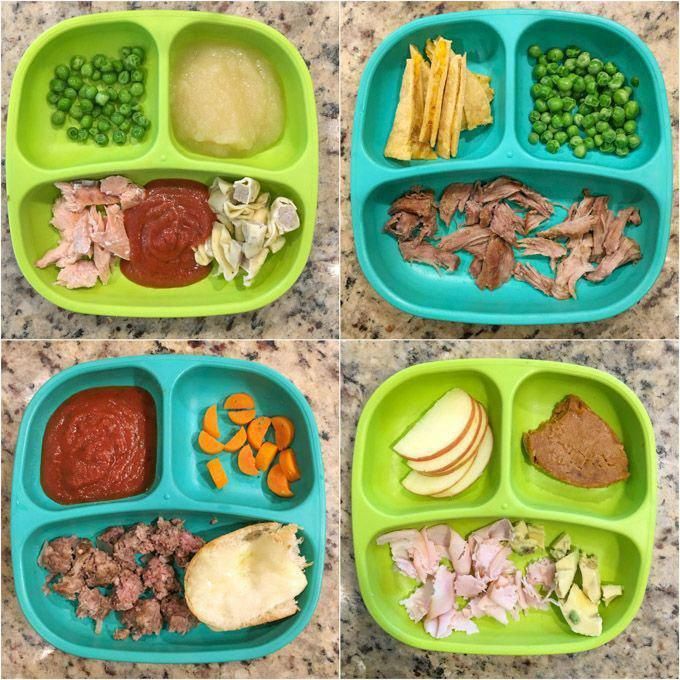When do babies start feeding themselves finger foods
Finger Foods for Babies (for Parents)
When babies begin feeding themselves — a new task most really enjoy — they'll find that they like trying new tastes and textures.
By the time they're 9 months old, most babies have developed the fine motor skills — the small, precise movements — needed to pick up small pieces of food and feed themselves. You may notice that yours can take hold of food (and other small objects) between forefinger and thumb in a pincer grasp. The pincer grasp starts out a little clumsy, but with practice soon becomes a real skill.
Let your child self-feed as much as possible. You'll still help by spoon-feeding cereal and other important dietary elements. But encouraging finger feeding helps your child develop independent, healthy eating habits.
Finger feeding — and using utensils a little later — gives babies some control over what they eat and how much. Sometimes they'll eat the food, sometimes not, and that's all part of the process of learning self-regulation. Even little kids can tell when they're hungry or full, so let them learn to recognize and respond to these cues.
What Should a Baby Eat?
Now that they're joining the rest of the family for meals, older babies are ready to try more table foods.
This means more work for whoever makes the meals for the family, but dishes often can be adapted for the baby. For instance, your little one can have some of the zucchini you're making for dinner. Cook that serving a bit longer — until it's soft — and cut it into pieces small enough for the baby to handle. Pieces of ripe banana, well-cooked pasta, and small pieces of chicken are other good choices.
Before giving your child a finger food, try a bite first and ask yourself:
- Does it melt in the mouth? Some dry cereals and crackers that are light and flaky will melt in the mouth.
- Is it cooked enough so that it mushes easily? Well-cooked veggies and fruits will mush easily, as will canned fruit and vegetables (choose ones without added sugar or salt).

- Is it soft? Cottage cheese, shredded cheese, and small pieces of tofu are good examples.
- Can it be gummed? Pieces of ripe banana and well-cooked pasta can be gummed.
- Is it small enough? Food should be cut into small pieces. The sizes will vary depending on the food's texture. A piece of chicken, for instance, needs to be smaller than a piece of watermelon, which even a pair of baby gums will quickly smash.
If your child doesn't like a food, don't let that stop you from offering it at future meals. Kids are naturally slow to accept new tastes and textures. For example, some are more sensitive to texture and may reject coarse foods, such as meat. When introducing meat, it's helpful to start with well-cooked ground meats or shreds of thinly sliced deli meats, such as turkey.
Present your baby with a variety of foods, even some that he or she didn't seem to like the week before. Don't force your baby to eat, but realize that it can take 10 or more tries before a child will accept a new food.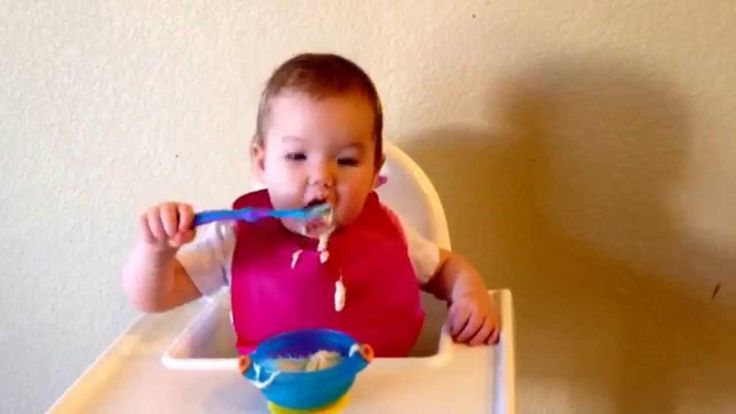
Finger Foods to Avoid
Finger feeding is fun and rewarding for older babies. But avoid foods that can cause choking and those with little nutritional value.
Choking Hazards
Parents and caregivers can help prevent choking by supervising the baby during eating. Foods that are choking hazards include:
- pieces of raw vegetables or hard fruits
- whole grapes, berries, cherry or grape tomatoes (instead, peel and slice or cut in quarters)
- raisins and other dried fruit
- peanuts, nuts, and seeds
- large scoops of peanut butter and other nut or seed butters (use only a thin layer)
- whole hot dogs and kiddie sausages (peel and cut these in very small pieces)
- untoasted bread, especially white bread that sticks together
- chunks of cheese or meat
- candy (hard candy, jelly beans, gummies, chewing gum)
- popcorn, pretzels, corn chips, and other snack foods
- marshmallows
Hold the Sweets
At first bite, your baby probably will love the taste of cookies, cake, and other sweets, but don't give them now.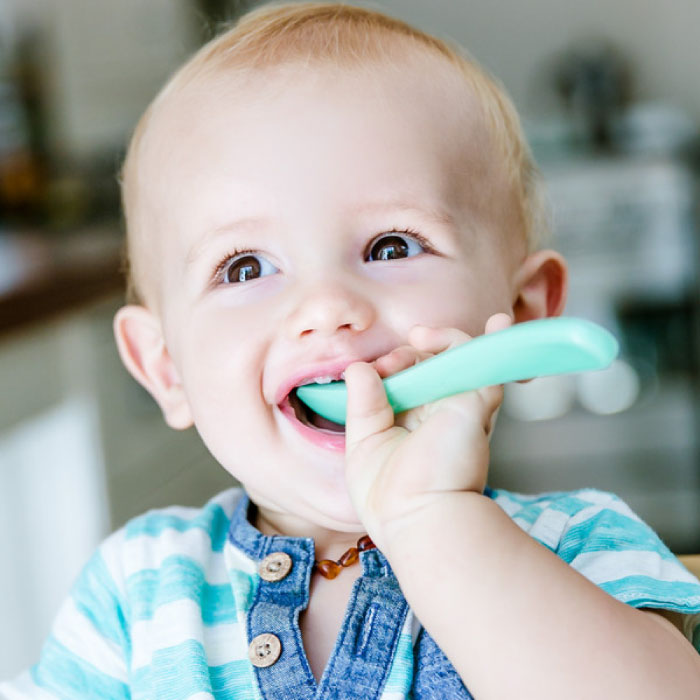 Your little one needs nutrient-rich foods, not the empty calories found in desserts and high-fat snacks, like potato chips.
Your little one needs nutrient-rich foods, not the empty calories found in desserts and high-fat snacks, like potato chips.
It's tempting to want to see the baby's reactions to some of these foods, but now is not the time. Grandparents and others may want to rush your baby into trying triple-chocolate cake or some other family favorite. Politely and firmly explain that the baby isn't ready for those foods. You can blame this tough love on your child's doctor — the doctor won't mind.
When to Introduce a Spoon to Baby
Learning how to self-feed is an important milestone in your baby’s development. The messy, but fun, process of teaching your baby how to use a spoon will be the next step in your baby’s journey to self-feeding.
Teaching your baby how to self-feed is going to be a messy process, but will be worth it in the long run. Your baby's motor skills and development will benefit from learning how to self-feed so it is important to encourage this process to your baby. As you begin to approach the age where your baby is ready to start learning how to self-feed, here is everything you should consider.
As you begin to approach the age where your baby is ready to start learning how to self-feed, here is everything you should consider.
Where To Start
Finger Feeding
Before you start to think about introducing a spoon to your baby, you first will want to make sure your baby has been introduced to finger foods. This first step will help your baby begin to develop their motor skills which are necessary to have before figuring out how to use a spoon.
Beginning with finger foods, start with soft foods that you can easily smash with your fingers. This will be the safest and easiest place to start for your baby. Foods such as soft cooked noodles, cut bananas, or steamed veggies are all a good place to begin. Choosing foods that can be cut up into bigger chunks will also make it easier for your baby to be able to pick up.
If you have only been feeding your baby soft foods and purees on your own, you should wait to introduce a spoon until after you have introduced finger foods. At around 12 months, most babies should be feeding themselves finger foods. It is around this stage that you can start to introduce a spoon.
At around 12 months, most babies should be feeding themselves finger foods. It is around this stage that you can start to introduce a spoon.
Next Step: Introducing the Spoon
Now that your baby has gotten comfortable with finger feeding, you can take the next step on the self-feeding journey by introducing their first utensil, a spoon. The CDC recommends waiting to introduce a spoon to your baby until they are around 10-12 months old. However, there is no specific age or time that your baby should developmentally be using a spoon. There are many factors that can have an influence on the timing of your baby learning to use a spoon.
- Fine motor skill development
- Interest in eating independently
- Time they have been eating solid foods
- First introduced to finger foods
These are all factors that can influence when your baby starts to use a spoon to self-feed. Every child is unique so do not worry about whether or not your baby is successfully learning to use a spoon. They will get there eventually!
They will get there eventually!
Signs They Might Be Ready
It can be tricky to know whether or not your baby is ready to take the next step in their development. One sign that your baby is likely ready to start using a spoon on their own is with their body language. Infants typically will turn their heads and clamp their mouth to signal they are full, after the meal. The opposite holds true as they get older. Toddlers will often start to get fussy or throw a tantrum before a meal. If you are noticing that they are appearing disinterested in the spoon you are trying to feed them, let themselves give it a try. This might be their way of telling you they are ready to be more independent.
Learn more from Pediatrician Dr. David Hill from the American Academy of Pediatrics about when your baby is ready for solids:
Expected Timeline
Depending on your baby, these milestones will be reached at different times than the families around you.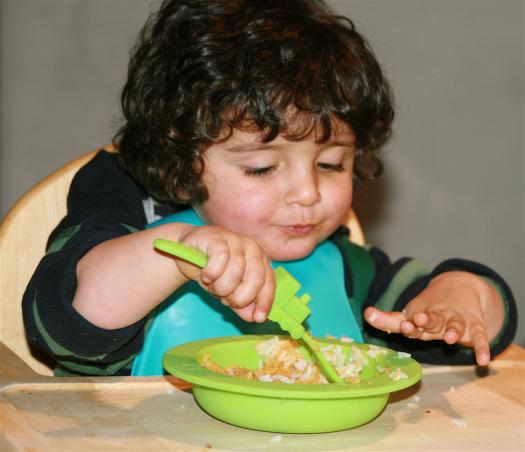 However, here is a general guide to understanding when you should plan on your baby reaching these steps to independently self-feeding.
However, here is a general guide to understanding when you should plan on your baby reaching these steps to independently self-feeding.
- 6 months: You can begin to start introducing finger foods to build your baby’s fine motor skills. Remember to choose foods that are soft and easy to squish to avoid any choking hazards.
- 12 months: Around their first birthday, your baby will likely begin showing an interest in using a spoon themselves. This is when you can begin letting your child feed themselves thick, soft foods like oatmeal, yogurt, or applesauce.
- 15-22 months: Your toddlers should be able to start getting the hang of feeding themselves with a spoon. Around this time, you should also be able to introduce using a fork to feed themselves.
Every baby is different when it comes to reaching these developmental milestones. You should never focus too much on whether or not your baby is “on track.” With both time and practice, your baby will get there.
What are the Benefits of Self-Feeding?
Self-feeding is your baby’s first step to independence. In addition to the new confidence and sense of freedom your baby is experiencing, self-feeding is beneficial to their overall development in the following ways.
- Learning to grasp and hold things firmly
- Gaining hand-eye coordination (learning spatial awareness, strengthening their “visual motor skills”)
- Refining Sensory Process skills (the different textures and sensations of the food they are touching will help to build their sensory processing skills)
Things to Consider
Picking the Right Spoon
In general, any spoon that is not too heavy for your baby to hold is the right spoon. However, it is probably a good idea to purchase a set of spoons that are actually designed to be used for babies. Look for spoons that have a wide, chubby handle that will make it easy for your baby to grab and pick up. A spoon made of rubber or silicone will also be better for your baby because of the soft texture and grippy material.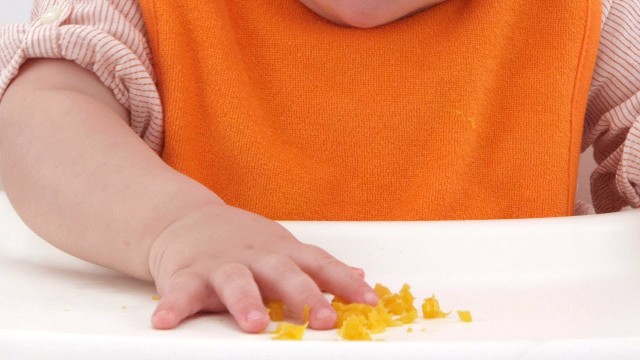
Foods to Start With
Get ready for a big mess when it comes to your baby learning how to use a spoon. At first, your baby will likely spend more time exploring and playing with their food, rather than actually eating it. Start with thick foods that will easily stay on the spoon as they learn how to balance and bring the spoon to their mouth. Here are some recommended foods to start with.
- Applesauce
- Cottage cheese
- Mashed peas/carrots
- Mashed potatoes
- Oatmeal
- Pasta
- Pudding
- Yogurt
Introducing the Fork
So, your baby has now mastered the spoon and is ready for their next big step: the fork. It is usually recommended to introduce the spoon before the fork, because a spoon is typically easier for a baby to learn at first. However, some babies do pick up on the fork easier because it requires less balancing and they can stab the food. You will likely want to introduce the fork at around 16-18 months, to give your baby time to first practice and focus on learning how to use a spoon.
What’s Next?
With so many huge developmental milestones being achieved, your baby is rapidly developing. Once your baby has been introduced to the spoon and fork, you can consider moving them from the high chair to a booster seat at the table. By bringing your baby to the table to eat with you, you can help them develop their motor skills quicker. This gives them the opportunity to observe and mirror your actions.
How Can I Help the Process?
The best way you can help your baby is to simply let them experience and explore this new skill for themselves. At first, you'll probably notice that your baby spends more time playing and waving the spoon around. But eventually, they will start to pick up on how to actually use the tool for their self-feeding benefit.
This is a messy, but fun, process. Look into some rubber or silicone splat mats to make the clean up aftermath easier for you. Other than letting your baby explore and have fun with the learning process, here are some things you can do to help your baby with practicing their new skill.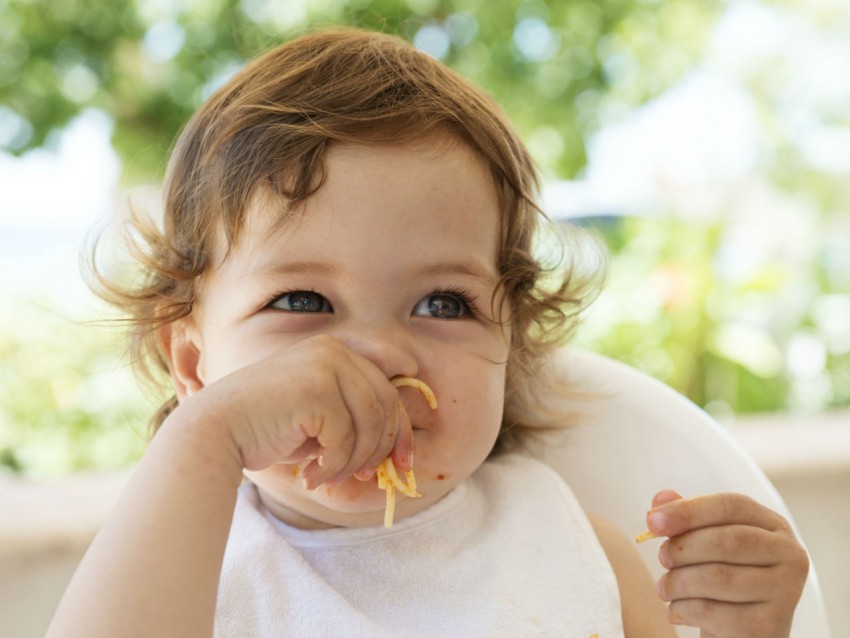
- Demonstrate it for them: Your baby is looking to you for guidance, so show them how it is done! Have them watch you use a spoon to feed yourself the yogurt or oatmeal and then have them try it for themselves. Over time, they will continue to mirror your actions for how to self-feed.
- Hand-Over-Hand Method: First, let your baby grab for the spoon themselves. Once they are holding the spoon, see if they can dip the spoon and scoop up the food. You can place your hand over their hand and help guide the food into their mouth. Your baby is still learning all the basics like where their mouth even is and how to scoop food using the spoon so you can help show them the ropes for the first few times.
- Stick to Thick Foods: To make it easier for your baby to scoop and bring the food into their mouth, stick to thick foods at first. Avoid foods that can easily fly off the spoon (rice, cereal, etc.) until they have gotten used to the process.
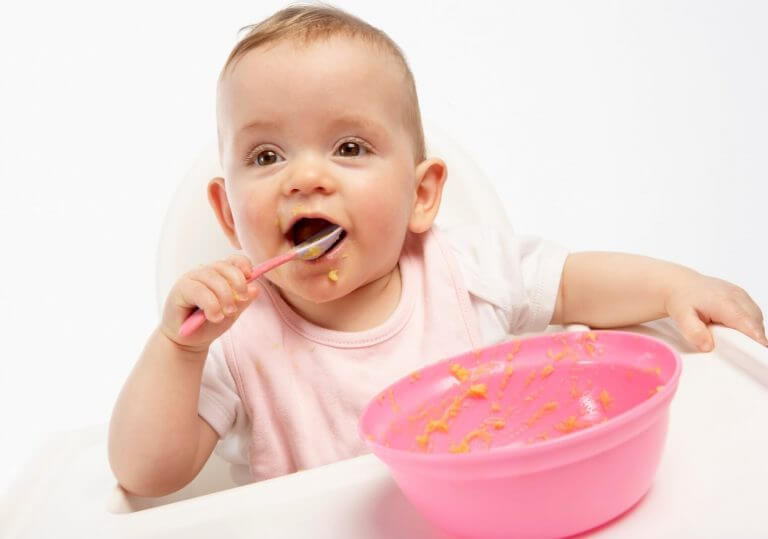
Baby-Led Weaning: What is it?
Baby-Led Weaning is a popular form of teaching self-feeding. The process skips feeding soft foods and purees and goes straight to finger foods starting at around 6 months. Registered dietician, Clancy Cash Harrison, author of Feeding Baby, says “Baby-led weaning supports the development of hand-eye coordination, chewing skills, dexterity, and healthy eating habits,” she says. “It also offers babies an opportunity to explore the taste, texture, aroma, and color of a variety of foods.”
What makes baby-led weaning successful, is that your baby will recognize that in order to eat, they need to learn how to do it themselves. It gives an extra nudge into independence. However, parents can obviously step in when needed, in order to make sure their baby is getting enough nutrition from food.
Starting at about 6 months, or whenever your baby is able to sit unassisted in a high chair, you can begin baby-led weaning. Your baby might not have fully developed their chewing skills so breast milk or formula will still need to be their main source of nutrition until at least 10 months old.
The best foods to begin with are soft, easy to squish foods like bananas, steamed broccoli, or avocado. Try cutting the foods into bigger pieces to make it easier for them to pick up. By starting at 6 months, you will help your baby develop the pincer grasp. When considering foods to start with, texture is key. Since your baby does not have the fully developed chewing skills, you will want to make sure any food you are giving them is very soft to avoid a choking hazard.
If you are thinking of starting baby-led weaning, consider a mixed approach. The first few months of baby-led weaning might be more exploring, and less eating. Do not feel pressure to fully abandon breast milk, formula, or purees. Not all children will be ready for baby-led weaning and finger feeding at 6 months. Focus on making sure your baby is getting enough food, rather than trying to get them to self-feed.
The most important thing to take away from both self-feeding and baby-led weaning is to let your baby lead the process.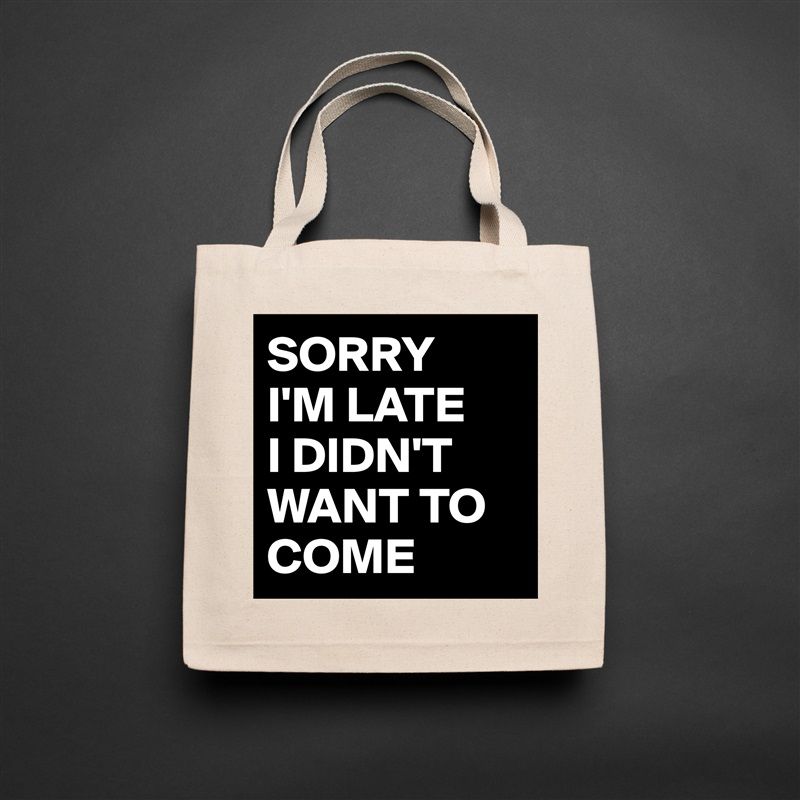 Let them be the one to reach for the spoon, show their curiosity, and explore their growing independence. Your baby will be most successful if you let them guide you in this process.
Let them be the one to reach for the spoon, show their curiosity, and explore their growing independence. Your baby will be most successful if you let them guide you in this process.
--------------------------------
All health-related content on this website is for informational purposes only and does not create a doctor-patient relationship. Always seek the advice of your own pediatrician in connection with any questions regarding your baby’s health.
These statements have not been evaluated by the Food and Drug Administration. Products are not intended to diagnose, treat, cure or prevent any disease.
See the FDA Peanut Allergy Qualified Health Claim at the bottom of our homepage.
Development of a child in the first year of life
During the first month alone, a baby gains 600-1000 grams in weight and 2-3 centimeters in height. Further, every month the child will, on average, add 500-900 grams, and grow by 2-3 centimeters.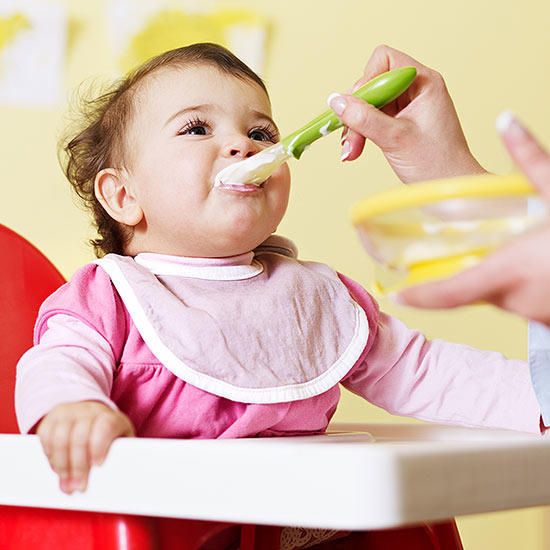
In the second half of the year, the child grows not so fast, on average he adds 400-500 grams, and growth increases by 1-2 centimeters per month. It is believed that by six months the weight of the child should double, and by the year - triple.
Of course, these figures are averaged. Much depends on the initial weight, heredity, method of feeding, etc. If the child is cheerful and healthy, but slightly behind in weight, then there is no reason for concern - everyone has their own growth rate.
1 month
The baby no longer seems as helpless and unintelligent as it looked in the first days after birth. By this time, he is already trying to follow the bright rattle, if it is smoothly moved in front of his eyes. When the baby is treated with affectionate words, he begins to listen, make the first sounds, smile. If the child is placed on his stomach, he will try to hold his head.
2 months
At this age, the baby easily follows a moving object, turns his head towards the sound source, and smiles a lot.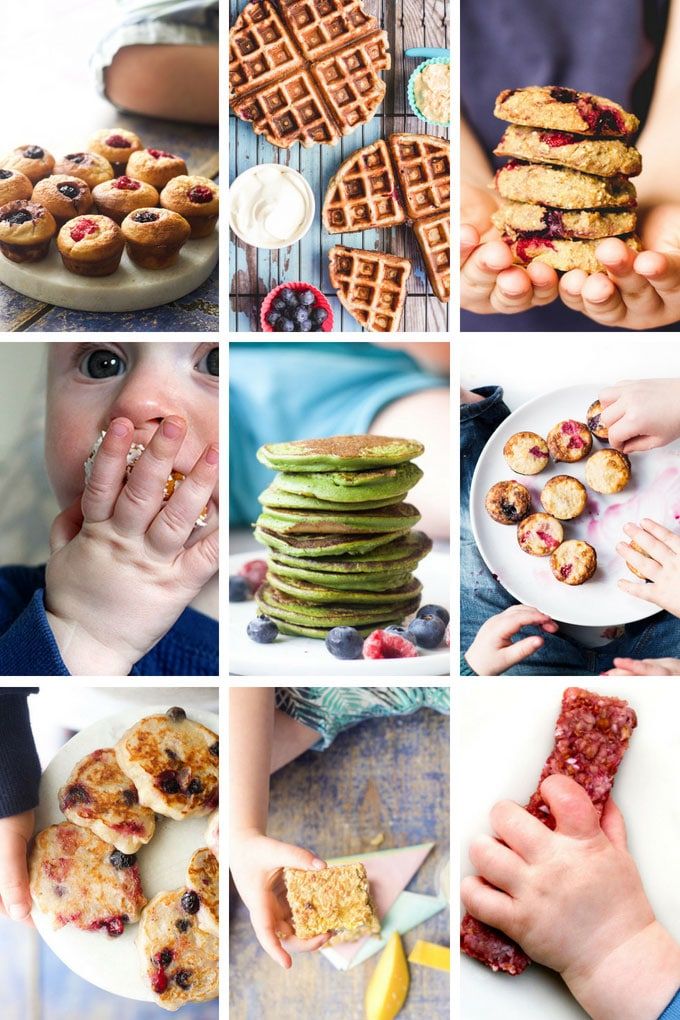 Makes a lot of sounds - hums. He holds his head well when lying on his stomach.
Makes a lot of sounds - hums. He holds his head well when lying on his stomach.
3 months
At three months, the child can focus on a fixed object. If you hang toys over him, he will try to get them with his hand. And if you put a rattle in his palm, he will be able to hold it for some time. With an affectionate appeal to the baby, he begins to briskly move his arms and legs, smile, walk - this is called the revitalization complex. In the prone position, he holds his head upright for a long time, leaning on his forearms. Tries to roll over from back to stomach.
4 months
The baby can already recognize his mother, father, laugh when communicating with them. Easily finds the source of the sound with his eyes, turns his head in his direction. He can take the rattle in his hands and hold it for a long time, look at it. All his movements become more conscious. The kid often studies his hands - he examines them for a long time, then bringing them closer, then moving them away from his eyes.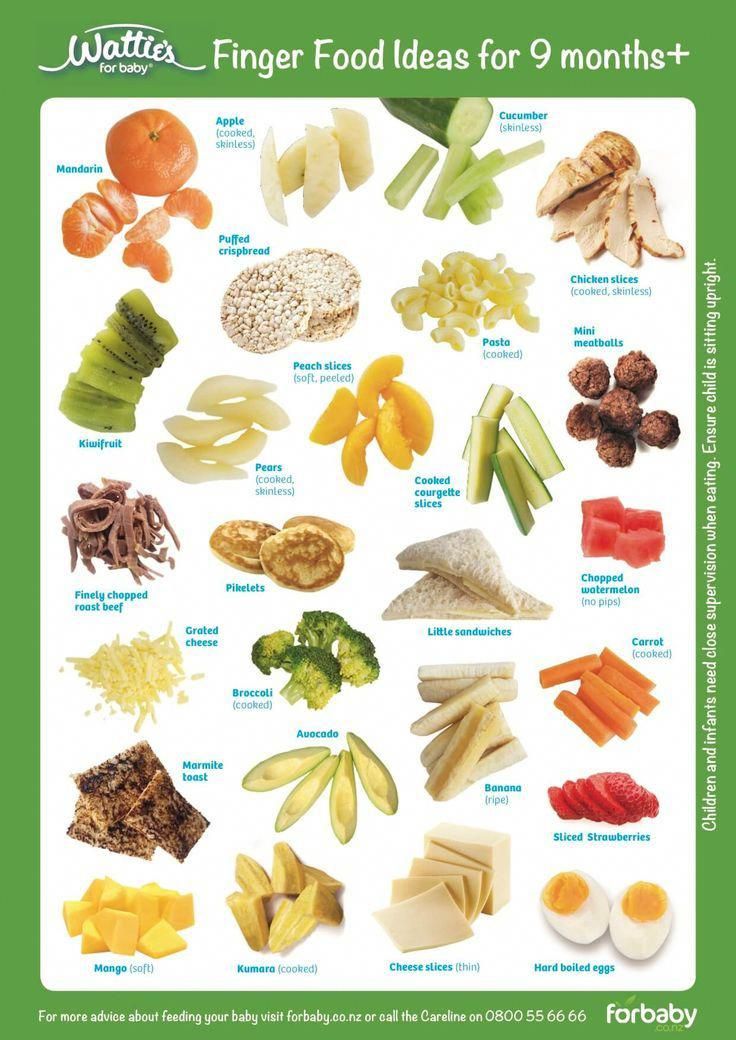
5 months
At this age, the child begins to distinguish between friends and foes, a strict and affectionate tone, respond to his name. Can talk to himself for a long time. Able to take a toy from the hands of an adult and play with it for a long time. Tries to roll over from stomach to back and crawl. If the baby is supported under the armpits, he rests on his legs and stands straight.
6 months
Since this age coincides with the age of introduction of complementary foods, the child learns to eat from a spoon, drink from a cup and sit in a high chair. Most six-month-old children already clearly know their name and respond to it. They begin to babble, while separate syllables “ba”, “ma” are heard. At this age, the first teeth usually erupt, so at night the baby may not sleep well and be naughty. During the day, periods of wakefulness reach 5-8 hours a day.
7 months
At seven months, the child is able to freely manipulate the toy - throwing, knocking, swinging, shifting. If the toy is put aside a short distance, the baby can crawl to it on its own. During wakefulness, he babbles for a long time, uttering the same syllables, and when asked "where" he tries to find a familiar object. During this month of life, the child continues to hone those skills and abilities that have already been mastered by him earlier. So, for example, he is already trying to sit down on his own, quickly crawl in different directions. Some babies even try to get up by holding on to the bars of the bed or sofa.
If the toy is put aside a short distance, the baby can crawl to it on its own. During wakefulness, he babbles for a long time, uttering the same syllables, and when asked "where" he tries to find a familiar object. During this month of life, the child continues to hone those skills and abilities that have already been mastered by him earlier. So, for example, he is already trying to sit down on his own, quickly crawl in different directions. Some babies even try to get up by holding on to the bars of the bed or sofa.
8 months
An 8-month-old baby is able to sit up, lie down, crawl, stand up and step over on his own. He himself can hold a cracker, a piece of an apple, a carrot in his hand and gnaw them. In general, at this age, the child pulls everything into his mouth - this is how he learns the world. In the game, he begins to imitate simple actions - he takes out, knocks, rolls a car, a ball. Can perform at the request of "patties", "magpie-crow", etc. Loudly, clearly pronounces individual syllables.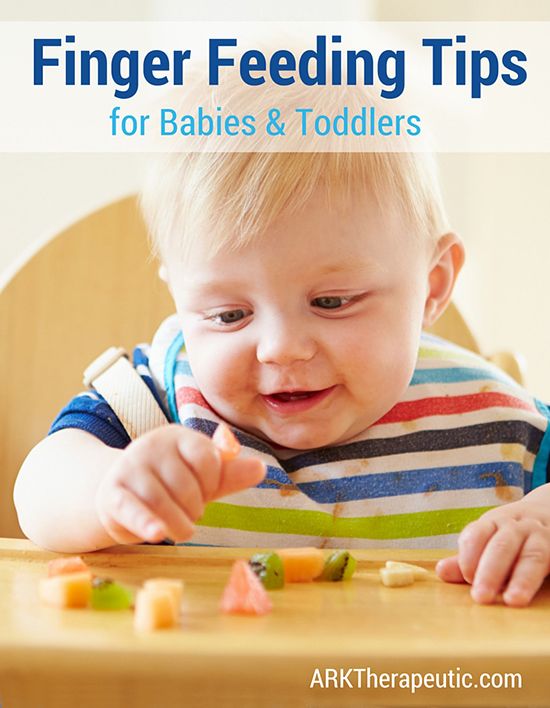 The spread of skills at this age is quite large - some children are already crawling fast, while others have just begun to sit. In general, the more complex the skill, the greater the spread in time required to master it.
The spread of skills at this age is quite large - some children are already crawling fast, while others have just begun to sit. In general, the more complex the skill, the greater the spread in time required to master it.
9 months
At this age, the child is drawn to communicate with his own kind. He will be happy to play with another child, imitate him, "talk" with him. Some babies walk holding on to a handle or some other support. However, crawling remains the main mode of locomotion. And sometimes the child crawls faster than the mother runs. Therefore, it's time to take care of the safety of the house in which the baby lives. Move all breakable objects, flower pots, computer system unit higher, secure electrical outlets, etc.
10 months
Improving the acquired skills is in full swing - the child, at the request, performs previously learned actions, to the question “where”, “give” he looks for the desired object. If the parents taught the child to eat with a spoon and drink from a cup, then at this age he is able to do it on his own. Imitates adults - repeats new syllables, actions with toys.
Imitates adults - repeats new syllables, actions with toys.
11 months
The time of the first steps, the first folded pyramids, the first words - “ma-ma”, “give”, “bye-bye”. The baby's babble becomes more varied and complex. At this age, the baby begins to distinguish between "us" and "strangers." Motor skills improve - movements become more coordinated and confident. Some children begin to walk during this period of time.
12 months
A storyline begins to be traced in the games - she feeds, puts the doll down, rolls it in the car. Knows many names of objects, toys, names of close people. Understands the word “no”, fulfills the instructions “bring”, “give”. Able to distinguish geometric objects - a cube, a ball. Vocabulary is expanding almost every day, and for especially advanced individuals it can be 10-15 words. He walks independently, actively moves around the house, interacts with various objects a lot and in a variety of ways.
Your child should have eight teeth by this age. Usually, the fontanel closes by the year, but there are no clear deadlines for closing the fontanel - this event can occur between 8 months and a year and a half.
Usually, the fontanel closes by the year, but there are no clear deadlines for closing the fontanel - this event can occur between 8 months and a year and a half.
Do not be upset if the child does not fit into the above schedule, because these are average data. Much depends on his individual characteristics. Usually, if a child lags behind in something, then it is ahead in another. And even if he is not ahead in anything, he will still sit down (get up, walk, speak) sooner or later. The main thing is to love the child for who he is.
References
- Obikane E., Baba T., Shinozaki T., Obata S., Nakanishi S., Murata C., Ushio E., Suzuki Y., Shirakawa N., Honda M., Sasaki N., Nishi D., O'Mahen H., Kawakami N. Internet-based behavioral activation to improve depressive symptoms and prevent child abuse in postnatal women (SmartMama): a protocol for a pragmatic randomized controlled trial. // BMC Pregnancy Childbirth - 2021 - Vol21 - N1 - p.314; PMID:33879065
- Zou ML.
 , Jiang CB., Chen YH., Wu CD., Candice Lung SC., Chien LC., Kallawicha K., Yang YT., Lo YC., Chao HJ. Effects of air pollution, land-use type, and maternal mental health on child development in the first two years of life in the Greater Taipei area. // Environ Res - 2021 - Vol - NNULL - p.111168; PMID:33857463
, Jiang CB., Chen YH., Wu CD., Candice Lung SC., Chien LC., Kallawicha K., Yang YT., Lo YC., Chao HJ. Effects of air pollution, land-use type, and maternal mental health on child development in the first two years of life in the Greater Taipei area. // Environ Res - 2021 - Vol - NNULL - p.111168; PMID:33857463 - Kvestad I., Hysing M., Kjellevold M., Næss S., Dahl L., Markhus MW. Maternal Cod Intake during Pregnancy and Infant Development in the First Year of Life: Secondary Analyzes from a Randomized Controlled Trial. // J Nutr - 2021 - Vol - NNULL - p.; PMID:33847344
- Gurdán Z., Szalma J., Benedek P. Achondroplasia from the viewpoint of orthodontics // Orv Hetil - 2021 - Vol162 - N17 - p.683-688; PMID:33838027
- Prytula V., Kurtash O. RECONSTRUCTIVE FUNCTIONAL RESERVOIRS IN TREATMENT OF CHILDREN WITH AGANGLIONOSIS AFTER TOTAL COLECTOMY. // Georgian Med News - 2021 - Vol - N311 - p.115-120; PMID:33814403
- Craft AL., Perry-Jenkins M., Newkirk K. The Implications of Early Marital Conflict for Children's Development.
 // J Child Fam Stud - 2021 - Vol30 - N1 - p.292-310; PMID:33795926
// J Child Fam Stud - 2021 - Vol30 - N1 - p.292-310; PMID:33795926 - Matusiak M., OzieRbło D., Obrycka A., Ołdak M., Kaczmarek L., Skarżyński P., Skarżyński H. Functional Polymorphism of MMP9 and BDNF as Potential Biomarker of Auditory Neuroplasticity in Prelingual Deafness Treatment With Cochlear Implantation-A Retrospective cohort analysis. // Trends Hear - 2021 - Vol25 - NNULL - p.23312165211002140; PMID:33787399
- Sarigiannis DA., Papaioannou N., Handakas E., Anesti O., Polanska K., Hanke W., Salifoglou A., Gabriel C., Karakitsios S. Neurodevelopmental exposome: The effect of in utero co-exposure to heavy metals and phthalates on child neurodevelopment. // Environ Res - 2021 - Vol197 - NNULL - p.110949; PMID:33716031
- Navaranjan G., Diamond ML., Harris SA., Jantunen LM., Bernstein S., Scott JA., Takaro TK., Dai R., Lefebvre DL., Azad MB., Becker AB., Mandhane PJ., Moraes TJ., Simons E., Turvey SE., Sears MR., Subbarao P., Brook JR. Early life exposure to phthalates and the development of childhood asthma among Canadian children.
 // Environ Res - 2021 - Vol197 - NNULL - p.110981; PMID:33691158 Food culture: until what age can a child play with food She wants her one and a half year old baby to get up from the table without a mask of grated vegetables and a spaghetti wig. But let's be realistic: children leave the table perfectly clean no earlier than 6-7 years old, although here too much will depend on your philosophy of life and the efforts made.
// Environ Res - 2021 - Vol197 - NNULL - p.110981; PMID:33691158 Food culture: until what age can a child play with food She wants her one and a half year old baby to get up from the table without a mask of grated vegetables and a spaghetti wig. But let's be realistic: children leave the table perfectly clean no earlier than 6-7 years old, although here too much will depend on your philosophy of life and the efforts made. - Photo
- Getty Images/Tetra images RF
- Photo
- Vesnaandjic/Getty Images/E+
Developmental activity
Development is facilitated by mastering any new skills. But the ability to eat and drink on your own brings special benefits. After all, sitting at the table, the baby not only trains taste buds. From about 6 months, the period of parting with the breast or the bottle begins. This is an important milestone on the path of separation from the mother and always the strengthening of autonomy and independence. Let someone get an apple for you, but you can already hold it in your hand and bring it to your mouth without outside help. From this point of view, the child should start learning to serve himself as early as possible.
From this point of view, the child should start learning to serve himself as early as possible.
From the age of six months, the baby's status also changes: as soon as he sits on the highchair and gets the opportunity to eat with everyone, he becomes a full member of the family meal. Now he is ready to try common dishes and have pleasant conversations. Only here good manners are given to him not at once. But most annoying is the untidiness and the obligation to wash half the kitchen at least five times a day and the unlucky eater to boot. From here comes the keen desire to spoon-feed him all the way to school.
If you succumb to such temptation and abruptly stop any exciting experiments with food, your ultimate goal is probably quite noble: to quickly teach your baby to eat culturally, so as not to blush for him at a party or in a restaurant. But a small child is at a different level of psychomotor development, he is simply not able to fulfill your standard for neatness and prudence.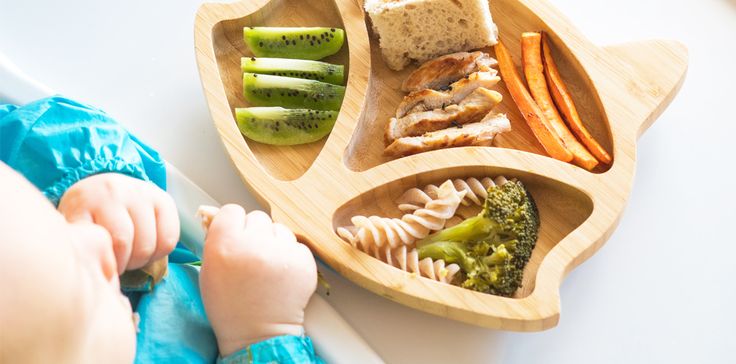
Treat dirty clothes easier. Imagine the scales and think about what is more important: gradual, timely and harmonious development or a soiled T-shirt. Moreover, most of the most unpleasant issues are removed by the washing machine. And the good old oilcloth, shabby dress and classic bib help to relax completely.
Jokes aside
If a child behaves ugly, a red card should appear after your warning and the offender should be sent off the table. It's important to keep your word. If the threat is not followed by any action on your part, it is perceived as a game.
By the way!
Recently, self-feeding has become popular with mothers of babies. No mashed potatoes and liquid porridge. Babies eat with their hands, choosing their own food. They just take what they like best from the plate: vegetables, fruits, pieces of meat, pasta. It looks impressive.
Forbidden games
True, some moments will have to be regulated. Take food games. The question of whether it is possible to let the baby sculpt a locomotive out of bread torments many parents. Young children experience the world through tactile activities. They need to touch everything, lick it, drop it, and it would be nice to hit something hard on the table. Our task is to provide them with such an opportunity. This means that quite calmly, up to 1.5–2 years old, you can allow the child to play with food. As he wants.
Young children experience the world through tactile activities. They need to touch everything, lick it, drop it, and it would be nice to hit something hard on the table. Our task is to provide them with such an opportunity. This means that quite calmly, up to 1.5–2 years old, you can allow the child to play with food. As he wants.
By the age of 2 this shop should be closed. Now offer your baby other games with food, more intellectual. For example, ask him to cut vegetables and fruits of different colors into small pieces with a serving or plastic knife. With them, you can then come up with different tasks. Before collecting the salad, the pieces are allowed to sort by color or try them with your eyes closed. You can also lay out patterns, landscapes, animal faces from pieces. By the way, such games help children make friends with those vegetables that they did not like before.
The less swearing and endless remarks, the faster any skill is mastered. This is a universal law. The learning process should bring joy to both the child and the mother.
The learning process should bring joy to both the child and the mother.
If the child starts throwing food, the game should be stopped. To prevent this from happening, next time try to distinguish between eating and playing time. If the baby is not hungry, most likely, pampering at the table cannot be avoided. But it’s enough to follow simple rules: follow the regimen and not snack, especially with the wrong foods, which, among other things, interrupt your appetite and pervert your eating habits, stop eating on time. As soon as the baby starts to play pranks (knocks over the plate, throws food at you), you need to stop him: "Now we eat, then we'll play."
Cheers!
The first self-care skill can be the ability to drink on your own. If mom allows. You can give your baby a sippy cup and a cup from 6 months.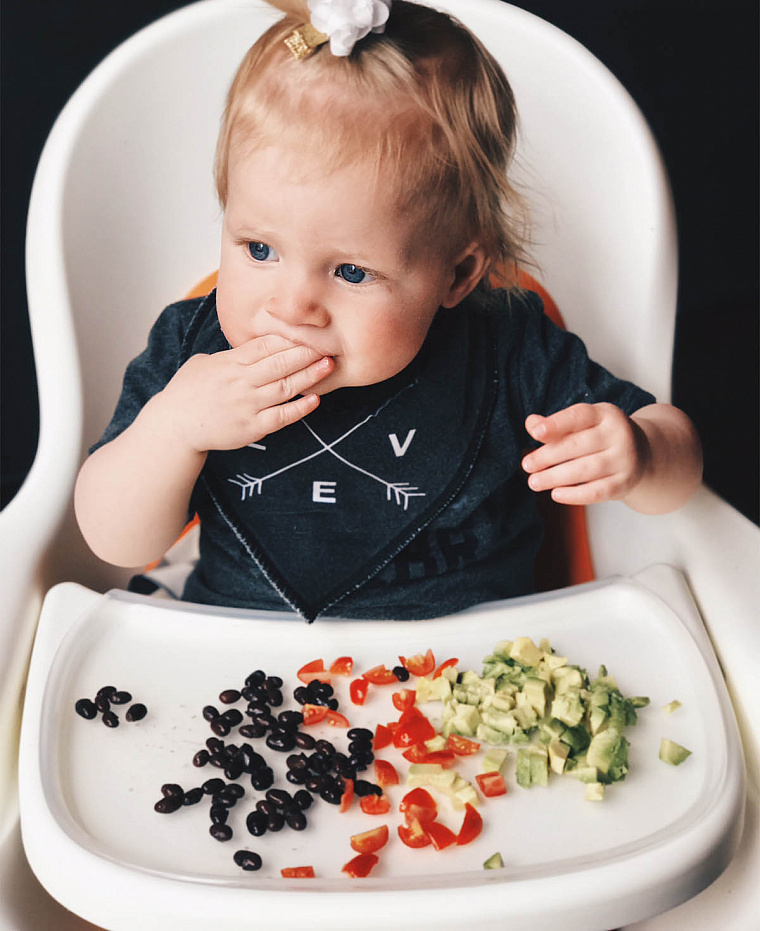 At this age, he will be able to firmly hold them in his hands, but, most likely, he will not immediately guess about their purpose.
At this age, he will be able to firmly hold them in his hands, but, most likely, he will not immediately guess about their purpose.
No violence. Show how you drink so that the baby can copy you. Play with plush animals in the desert and oasis. And be patient. Although most children really like this new and unusual process, especially if you pour not water, but compote or jelly into the drinker.
If the first attempts fail, postpone them for a while. Try again in a couple of weeks or a month, after hiding the mug from view for the duration of the moratorium. The main thing is to be in time for 2 years. By this age, the ability to drink on their own should be formed. And it does not matter, with the help of a drinking bowl or a cup: the mother decides this issue at her discretion. Many children are interested in mastering an adult mug, while others are drawn to more reliable non-spillers. See what intrigues the baby more. If desired, both accessories can be combined or alternated.
It is possible to use a knife, plastic or non-sharp serving, from the age of 2, but children learn to use this device to perfection not earlier than 6 years. Like a fork.
Spoons in hand
By about a year old, most children can already feed themselves. True, so far in a primitive manner - with the help of fingers. If you want to develop a child comprehensively, allow him this "disgrace". And keep looking. At the same time, babies usually wake up interest in a spoon. Do not miss the moment, gradually start learning. Just be prepared for the fact that at first the spoon will be a toy for him and you will often enjoy the improvisations of an inspired drummer.
Over time, the baby will begin to learn to coordinate his movements, but for now, misses and mistakes are natural. So a dirty face is in the order of things. The ability to use a spoon will be fully developed by about 20-24 months, so be indulgent. The more you rush the child, the higher the likelihood that the process will be delayed.
So a dirty face is in the order of things. The ability to use a spoon will be fully developed by about 20-24 months, so be indulgent. The more you rush the child, the higher the likelihood that the process will be delayed.
When it's time to exercise like a grown-up, for safety's sake, give your baby a plastic spoon, and for convenience, buy a plate with suction cups. Make sure that the first portions are thick enough. It will be extremely difficult to deal with soup, and it is easier to tame porridge or cottage cheese. Moreover, it is much more convenient to “transport” them into the mouth (and it is more pleasant to scrape off the table). Just remember to set an example for your child. For learning to take place in the form of a game, ask him to feed you from a spoon more often.
It is advisable to feed the child according to the schedule, without snacks. Then there will be no need for games from the category “a spoon for mom”, “a train goes to her mouth”. It is important to separate meals and play time.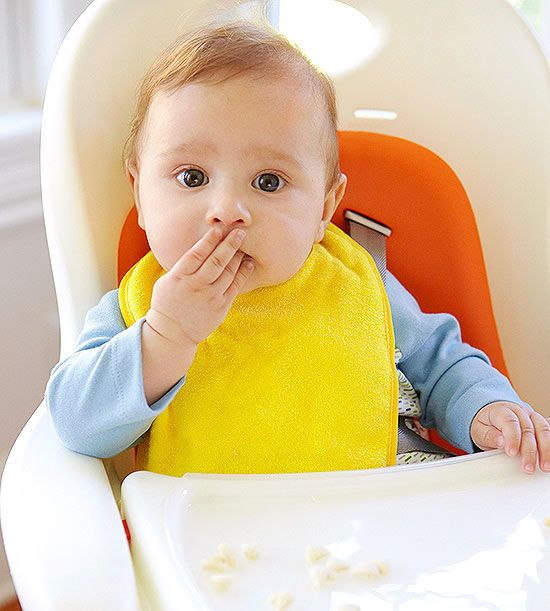
Good manners
The culture of behavior at the table begins to take shape in the family. The best period for mastering good manners is a year and a half. But doing something on purpose is almost pointless. Children will still take an example from you. If it is not customary to use napkins at home, it will be strange to expect that a child will suddenly remember about them in a restaurant. The same goes for a serving knife, a separate plate for bread, the need to wash your hands before eating, and so on.
Do you want to reinforce the rules that you follow every day? It is best to play them in parallel also on toys. It's easier with girls: you can buy a plastic set for a doll and train on it. Although the boys like to set the table just as much. But in general, with children of either sex, it is useful to periodically play "ladies and gentlemen", for example, arranging a feast in honor of the "king" or "queen" elected by secret ballot. Practicing good manners is the easiest way.

